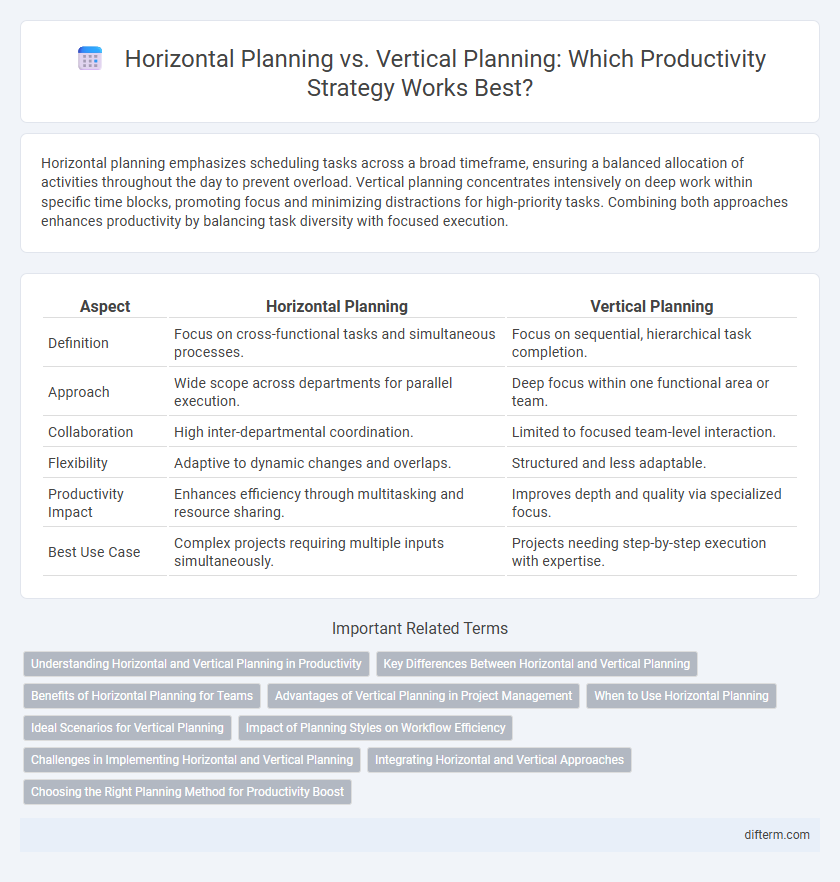Horizontal planning emphasizes scheduling tasks across a broad timeframe, ensuring a balanced allocation of activities throughout the day to prevent overload. Vertical planning concentrates intensively on deep work within specific time blocks, promoting focus and minimizing distractions for high-priority tasks. Combining both approaches enhances productivity by balancing task diversity with focused execution.
Table of Comparison
| Aspect | Horizontal Planning | Vertical Planning |
|---|---|---|
| Definition | Focus on cross-functional tasks and simultaneous processes. | Focus on sequential, hierarchical task completion. |
| Approach | Wide scope across departments for parallel execution. | Deep focus within one functional area or team. |
| Collaboration | High inter-departmental coordination. | Limited to focused team-level interaction. |
| Flexibility | Adaptive to dynamic changes and overlaps. | Structured and less adaptable. |
| Productivity Impact | Enhances efficiency through multitasking and resource sharing. | Improves depth and quality via specialized focus. |
| Best Use Case | Complex projects requiring multiple inputs simultaneously. | Projects needing step-by-step execution with expertise. |
Understanding Horizontal and Vertical Planning in Productivity
Horizontal planning in productivity emphasizes scheduling tasks across a broad time frame, allowing for flexibility and adaptation in daily activities. Vertical planning focuses on deep, sequential task execution within specific projects, enhancing detail orientation and efficiency in complex workflows. Understanding the distinction between horizontal and vertical planning helps optimize time management strategies and improve overall productivity outcomes.
Key Differences Between Horizontal and Vertical Planning
Horizontal planning focuses on coordinating tasks across multiple departments or teams simultaneously to ensure seamless workflow and resource allocation, while vertical planning emphasizes a top-down approach, aligning strategic objectives with detailed, step-by-step execution within a single department or project. Key differences include the scope of coordination--horizontal planning promotes cross-functional collaboration and flexibility, whereas vertical planning drives depth of control and hierarchical decision-making. Horizontal planning often enhances adaptability in complex environments, while vertical planning ensures clarity and accountability in specialized processes.
Benefits of Horizontal Planning for Teams
Horizontal planning enhances team collaboration by promoting cross-functional communication and aligning goals across departments. It fosters flexibility in resource allocation, allowing teams to adapt quickly to changing priorities and workloads. This approach improves overall productivity by breaking down silos and encouraging a unified strategy toward project completion.
Advantages of Vertical Planning in Project Management
Vertical planning in project management enhances focus by breaking down tasks into detailed, sequential steps, ensuring clearer accountability and better resource allocation. This approach improves risk management through early identification of potential bottlenecks and facilitates more precise progress tracking. By aligning tasks vertically, teams achieve higher productivity and effective milestone adherence.
When to Use Horizontal Planning
Horizontal planning is ideal for projects requiring simultaneous coordination across multiple departments or teams to ensure resource alignment and consistent timelines. It enhances cross-functional communication and facilitates collaboration in complex workflows with interdependent tasks. Use horizontal planning when flexibility and adaptability are crucial to accommodate changes without disrupting the entire project schedule.
Ideal Scenarios for Vertical Planning
Vertical planning excels in complex projects with hierarchical structures, such as software development or construction management, where tasks depend on sequential completion. It enables clear prioritization of critical path activities, ensuring resources are allocated efficiently to meet deadlines. This approach enhances focus on top-level goals by breaking down objectives into manageable layers, optimizing coordination across specialized teams.
Impact of Planning Styles on Workflow Efficiency
Horizontal planning enhances workflow efficiency by promoting cross-functional collaboration and synchronized task execution, reducing bottlenecks and enabling smoother transitions between project phases. Vertical planning, while fostering deep specialization and clear hierarchical accountability, can create silos that delay interdepartmental communication and slow overall progress. Balancing both styles optimizes resource allocation, accelerates decision-making, and drives higher productivity outcomes in complex organizational environments.
Challenges in Implementing Horizontal and Vertical Planning
Challenges in implementing horizontal planning include coordinating cross-functional teams, managing diverse priorities, and ensuring effective communication across departments to maintain alignment. Vertical planning faces difficulties in maintaining clear hierarchical oversight, addressing bottlenecks caused by rigid structures, and integrating feedback from lower levels without losing strategic focus. Both approaches require balancing flexibility and control to optimize productivity and prevent delays in decision-making processes.
Integrating Horizontal and Vertical Approaches
Integrating horizontal and vertical planning enhances organizational productivity by aligning cross-departmental collaboration with strategic goal setting. Horizontal planning focuses on coordinating tasks and workflows across teams for seamless execution, while vertical planning emphasizes hierarchical decision-making and long-term vision alignment. Combining these approaches ensures operational efficiency and strategic coherence, fostering adaptive project management and improved resource allocation.
Choosing the Right Planning Method for Productivity Boost
Horizontal planning emphasizes coordinating tasks across teams and departments simultaneously, enhancing collaboration and preventing bottlenecks. Vertical planning focuses on sequential task execution within a single team, ensuring deep specialization and streamlined workflow stages. Selecting the right planning method depends on project complexity, team structure, and the desired balance between flexibility and efficiency to maximize productivity gains.
Horizontal planning vs Vertical planning Infographic

 difterm.com
difterm.com